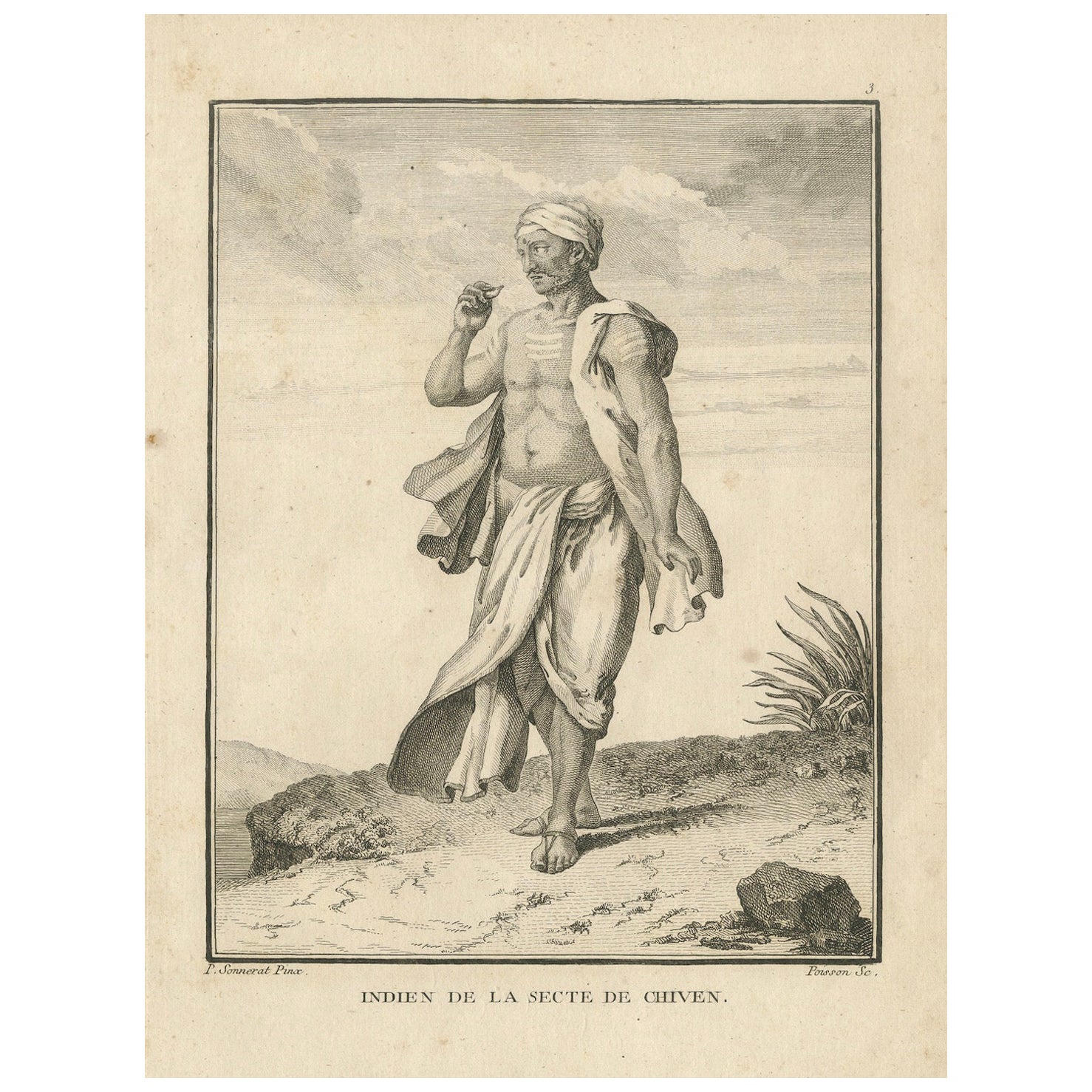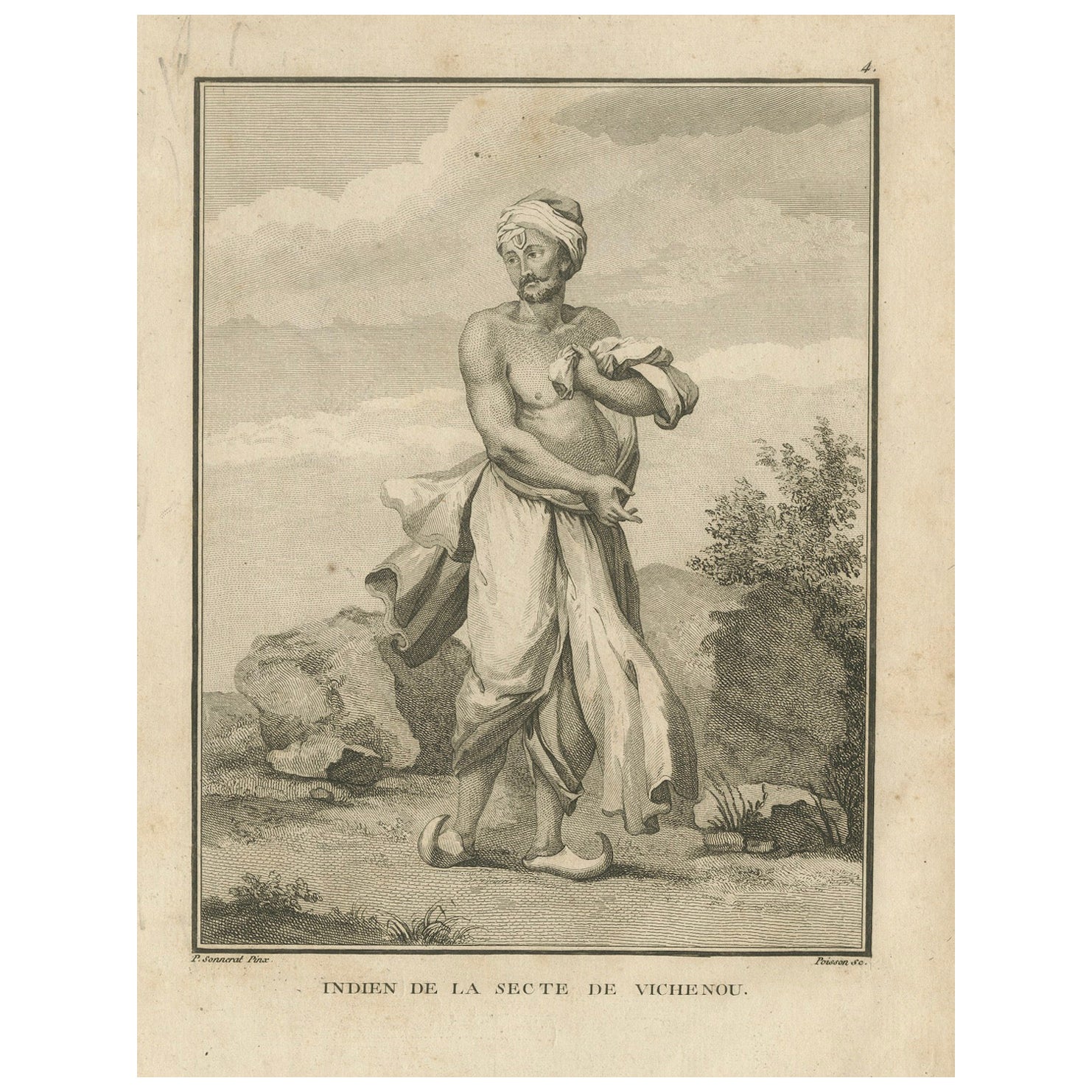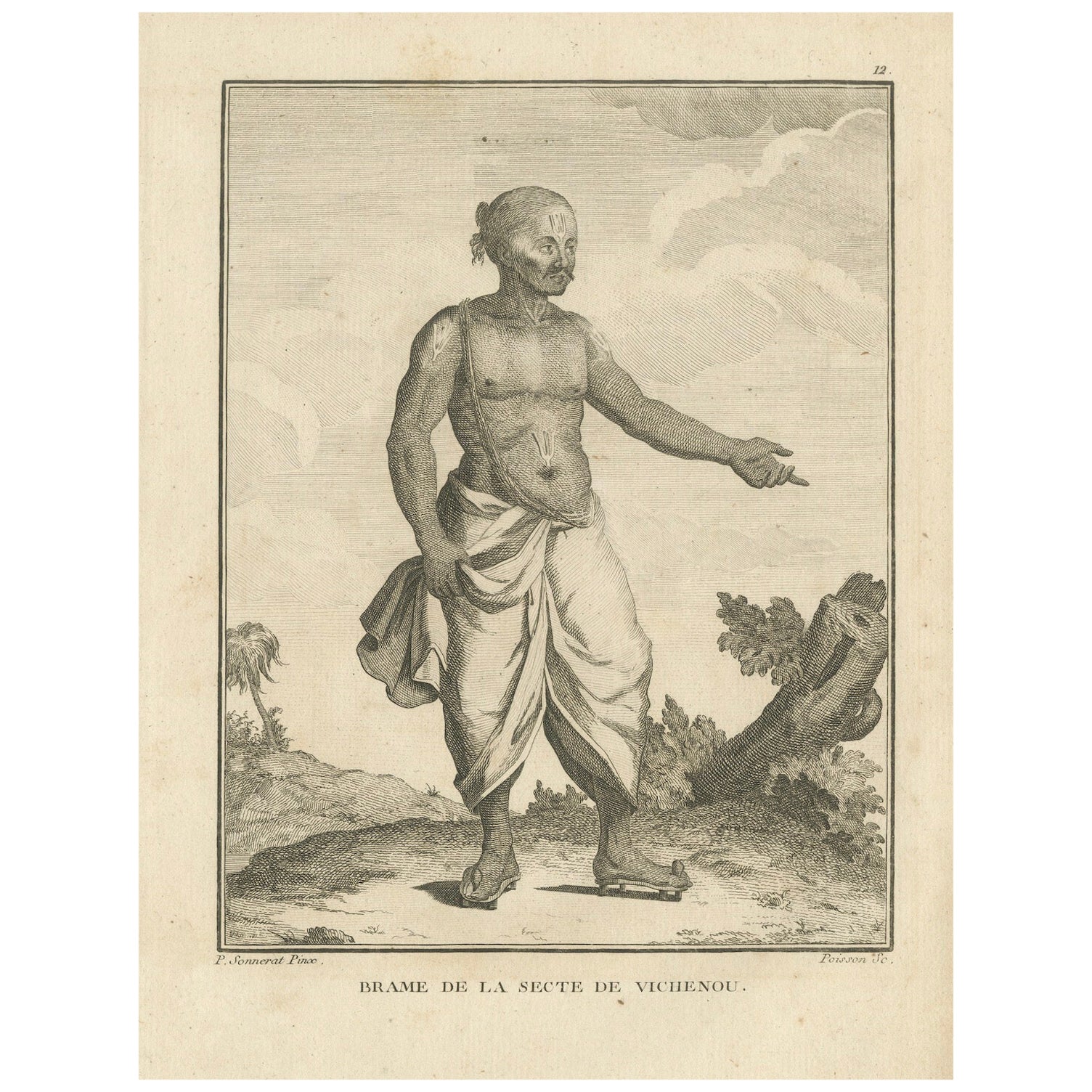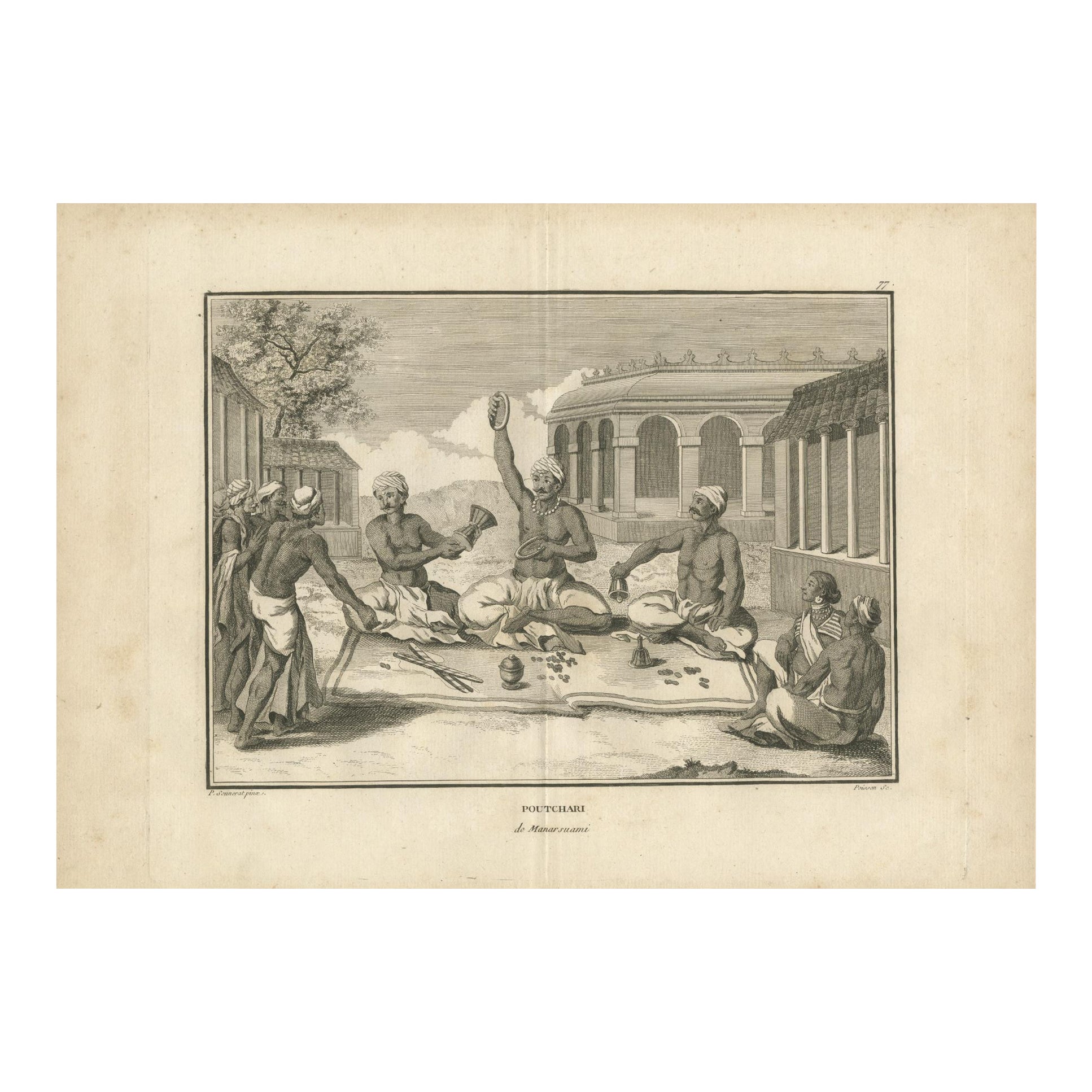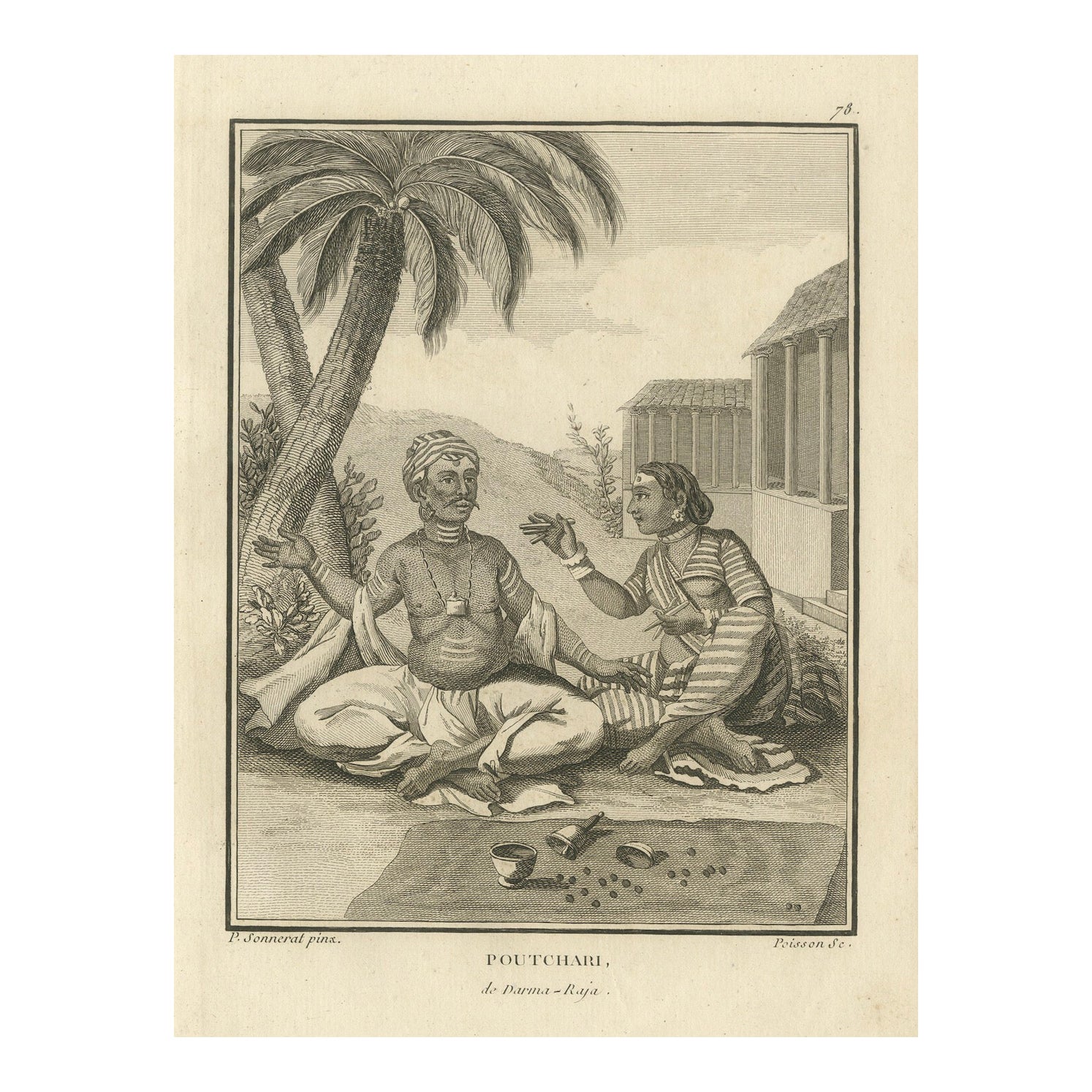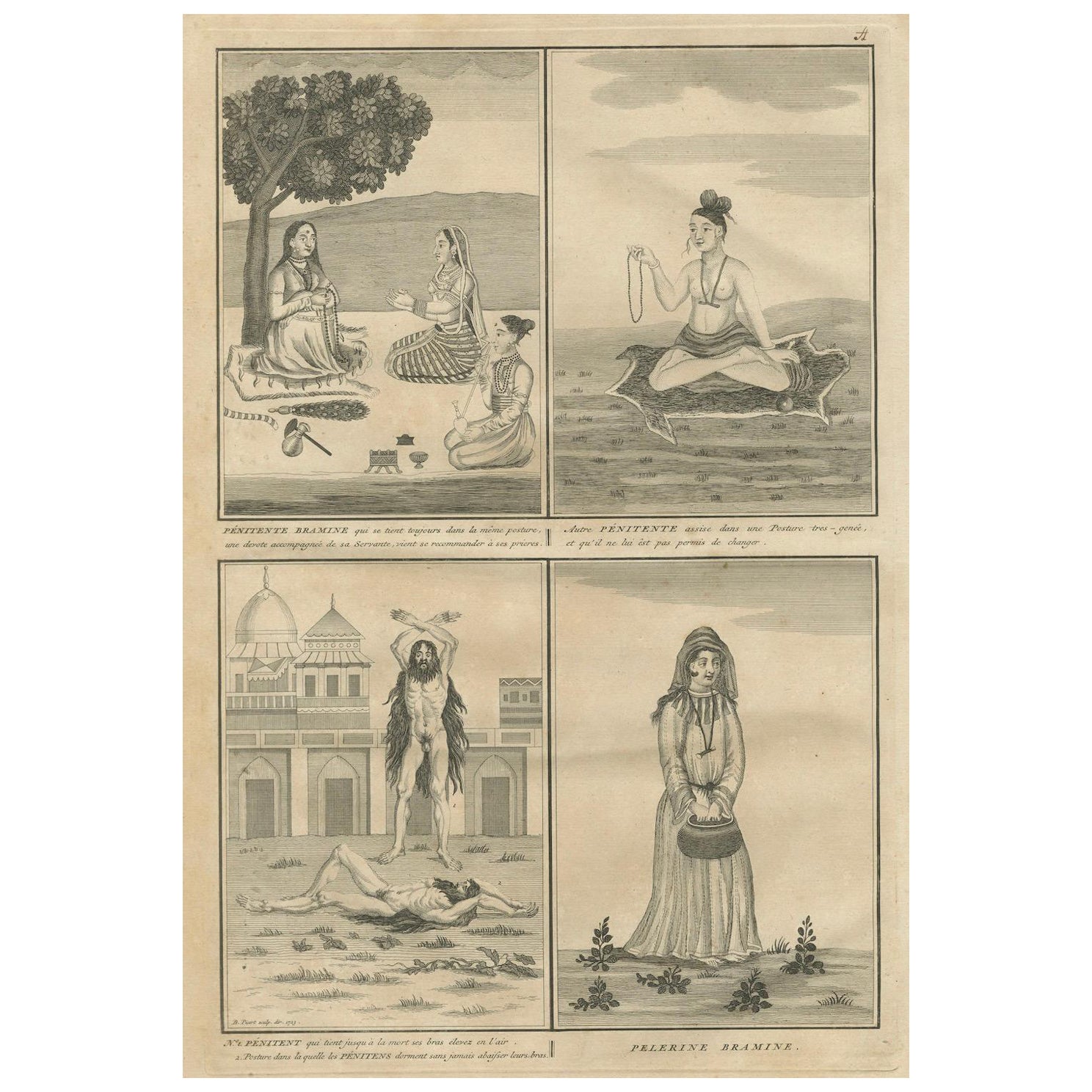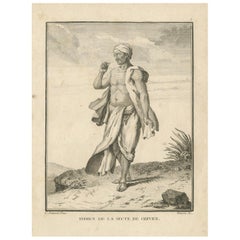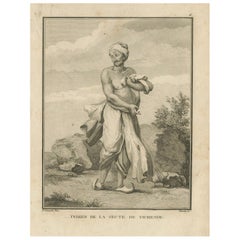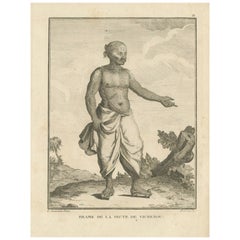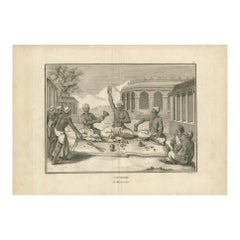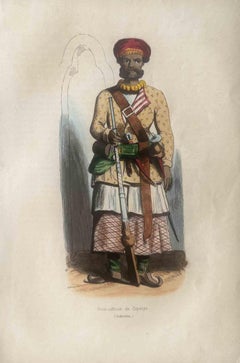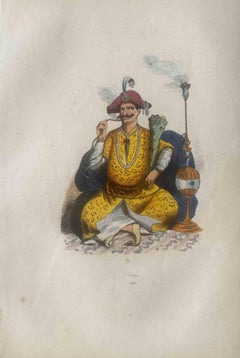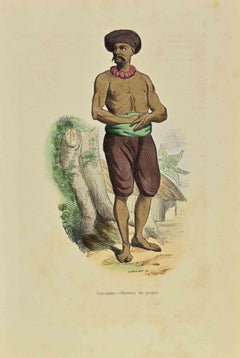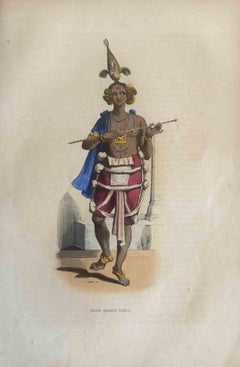Items Similar to Indian Penitent with Ritual Implements – Engraving after Sonnerat, 1806
Want more images or videos?
Request additional images or videos from the seller
1 of 10
Indian Penitent with Ritual Implements – Engraving after Sonnerat, 1806
$200.97
£151.31
€170
CA$277.37
A$310.72
CHF 161.61
MX$3,790.08
NOK 2,057.52
SEK 1,940.09
DKK 1,294.21
About the Item
Indian Penitent with Ritual Implements – Engraving after Sonnerat, 1806
This striking antique engraving titled Pénitent Indien (Indian Penitent) portrays a barefoot ascetic figure standing in a natural landscape, dressed in a simple dhoti and turban. He holds ritual items in both hands: a small bowl in one and a bundle of peacock feathers or ceremonial fronds in the other. His chest is bare, and his expression calm yet focused. A notable feature is the pierced rod or ritual instrument extending through his cheeks or jaw—an act of self-mortification associated with certain religious practices in South India.
This figure likely represents a devotee engaged in vows of penance or public expressions of religious endurance, often observed during processions, pilgrimages, or festivals. The practice of body piercing—particularly cheek or tongue piercing—is historically associated with Tamil Hindu traditions, especially in devotion to deities like Murugan. These acts were seen as demonstrations of personal sacrifice and spiritual resolve.
Drawn by Pierre Sonnerat (1745–1814), a French naturalist and explorer, and engraved by Jean-Baptiste-Marie Poisson (1747–1820), the image was published in the 1806 edition of *Voyage aux Indes Orientales et à la Chine*. Sonnerat aimed to document the customs, religious practices, and appearances of Indian people during his extensive travels. This particular image stands out for its sensitive depiction of ritual intensity, capturing both the stillness and spiritual gravity of the figure.
This print is a valuable artifact for those interested in the history of Hindu ritual, colonial-era visual ethnography, or Orientalist art. It offers a rare early 19th-century European interpretation of practices that were both revered and misunderstood in Western accounts.
Condition report:
Good condition. Slight age toning and foxing in margins. Fold line visible near the binding edge. Image well-inked with strong detail throughout.
Framing tips:
Best suited to a dark wood or ebonized frame with a wide off-white or soft gray mat. This will highlight the figure’s form and enhance the contrast of the engraved lines.
Technique: Engraving
Maker: J.-B.-M. Poisson after Pierre Sonnerat, Paris, 1806
- Dimensions:Height: 11.23 in (28.5 cm)Width: 8.27 in (21 cm)Depth: 0.01 in (0.2 mm)
- Materials and Techniques:Paper,Engraved
- Place of Origin:
- Period:
- Date of Manufacture:1806
- Condition:Good condition. Slight age toning and foxing in margins. Fold line visible near the binding edge. Image well-inked with strong detail throughout.
- Seller Location:Langweer, NL
- Reference Number:Seller: BG-13429-781stDibs: LU3054346092952
About the Seller
5.0
Recognized Seller
These prestigious sellers are industry leaders and represent the highest echelon for item quality and design.
Platinum Seller
Premium sellers with a 4.7+ rating and 24-hour response times
Established in 2009
1stDibs seller since 2017
2,531 sales on 1stDibs
Typical response time: <1 hour
- ShippingRetrieving quote...Shipping from: Langweer, Netherlands
- Return Policy
Authenticity Guarantee
In the unlikely event there’s an issue with an item’s authenticity, contact us within 1 year for a full refund. DetailsMoney-Back Guarantee
If your item is not as described, is damaged in transit, or does not arrive, contact us within 7 days for a full refund. Details24-Hour Cancellation
You have a 24-hour grace period in which to reconsider your purchase, with no questions asked.Vetted Professional Sellers
Our world-class sellers must adhere to strict standards for service and quality, maintaining the integrity of our listings.Price-Match Guarantee
If you find that a seller listed the same item for a lower price elsewhere, we’ll match it.Trusted Global Delivery
Our best-in-class carrier network provides specialized shipping options worldwide, including custom delivery.More From This Seller
View AllIndian Follower of the Shaivite Sect – Sonnerat Voyage Engraving, 1806
Located in Langweer, NL
Indian Follower of the Shaivite Sect – Sonnerat Voyage Engraving, 1806
This antique copper engraving titled "Indien de la Secte de Chiven" (Indian of the Sect of Shiva) is plate num...
Category
Antique Early 1800s Prints
Materials
Paper
Indian Devotee of Vishnu – Engraving from Sonnerat's 1806 Voyage to India
Located in Langweer, NL
Indian Devotee of Vishnu – Engraving from Sonnerat's 1806 Voyage to India
This fine 18th-century engraving titled *Indien de la Secte de Vichenou* (Indian of the Sect of Vishnu) is ...
Category
Antique Early 1800s Prints
Materials
Paper
Vaishnavite Brahmin from India – Sonnerat Engraving, Paris Edition, 1806
Located in Langweer, NL
Vaishnavite Brahmin from India – Sonnerat Engraving, Paris Edition, 1806
This finely engraved plate titled *Brame de la Secte de Vichenou* (Brahmin of the Sect of Vishnu) is plate n...
Category
Antique Early 1800s Prints
Materials
Paper
Hindu Priestly Assembly – Poutchari of Maarraami, Engraving, 1806
Located in Langweer, NL
Hindu Priestly Assembly – Poutchari of Maarraami, Engraving, 1806
This detailed engraving titled Poutchari de Maarraami depicts a group of Hindu priests or temple functionaries sea...
Category
Antique Early 1800s French Prints
Materials
Paper
Hindu Couple with Ritual Implements – Poutchari of Darma Raja, 1806
Located in Langweer, NL
Hindu Couple with Ritual Implements – Poutchari of Darma Raja, 1806
This antique engraving titled Poutchari de Darma-Raja presents an intimate scene of a Hindu couple seated on the ...
Category
Antique Early 1800s French Prints
Materials
Paper
Indian Brahmin Penitents and Pilgrim – Rare 18th Century Ritual Engraving, 1734
Located in Langweer, NL
Title: Indian Brahmin Penitents and Pilgrim – Rare 18th Century Ritual Engraving
Description:
This compelling copperplate engraving from the 18th century offers a rare visual study of Indian religious asceticism and devotion as interpreted through a European lens. It likely originates from the later volumes of *The Ceremonies and Religious Customs of Various Nations of the Known World*, the monumental multi-volume series published in Amsterdam and Paris during the early to mid-1700s, with illustrations attributed to Bernard Picart and his collaborators.
The sheet is divided into four separately framed scenes, each depicting a unique figure engaged in acts of penance or pilgrimage. The upper left panel shows a seated female "Pénitente Bramine" (Brahmin penitent) under a flowering tree, joined by other women in a meditative or devotional posture. The details, such as the tiger skin mat and ceremonial tools, signal both religious symbolism and ritual practice.
The upper right image presents a solitary ascetic woman seated in rigid meditation on what appears to be a stretched animal hide floating in water, holding a prayer bead mala. The caption explains she must never change position, emphasizing the extremity of her discipline.
The lower left quadrant is the most dramatic: a male penitent with wild hair stands before a temple with both arms raised straight in the air, said to remain that way until death. Another figure lies prostrate in the grass, illustrating the prescribed sleeping posture for certain penitents—lying flat without ever bending their legs. These powerful visual representations underscore the physical trials undertaken by devout individuals in pursuit of spiritual transcendence.
In the lower right, a "Pélerine Bramine" (Brahmin female pilgrim) stands quietly, dressed simply, with a bowl in hand, perhaps engaged in ritual begging or...
Category
Antique 1730s Prints
Materials
Paper
You May Also Like
Uses and Customs - Indian - Lithograph - 1862
Located in Roma, IT
Uses and Customs - Indian is a lithograph on paper realized in 1862.
The artwork belongs to the Suite Uses and customs of all the peoples of the universe: " History of the governmen...
Category
1860s Modern Figurative Prints
Materials
Lithograph
Uses and Customs - Indian Rajah - Lithograph - 1862
Located in Roma, IT
Uses and Customs - Indian Rajah is a lithograph on paper realized in 1862.
The artwork belongs to the Suite Uses and customs of all the peoples of the universe: " History of the gov...
Category
1860s Modern Figurative Prints
Materials
Lithograph
Indoustan, Man of the people - Lithograph by Auguste Wahlen - 1844
Located in Roma, IT
Indoustan, Man of the people is a lithograph made by Auguste Wahlen in 1844.
Hand colored.
Good condition.
At the center of the artwork is the original title "Indoustan. Homme du ...
Category
1840s Modern Figurative Prints
Materials
Lithograph
Uses and Customs - Indian - Lithograph - 1862
Located in Roma, IT
Uses and Customs - Indian is a lithograph on paper realized in 1862.
The artwork belongs to the Suite Uses and customs of all the peoples of the universe: " History of the governmen...
Category
1860s Modern Figurative Prints
Materials
Lithograph
Customs - Rajput - Lithograph - 1862
Located in Roma, IT
Customs - Rajput is a Hand-colored lithograph on paper realized in 1862.
Titled on the lower.
The artwork belongs to the Suite Uses and customs of all the peoples of the universe :...
Category
1860s Modern Figurative Prints
Materials
Lithograph
Original Antique Print of An Arab Sheikh, 1817
Located in St Annes, Lancashire
Great image of an Arab Sheikh
Copper-plate engraving by T.Clerk
Published by Mackenzie And Dent. 1817
Unframed.
Category
Antique 1810s English Islamic Prints
Materials
Paper
